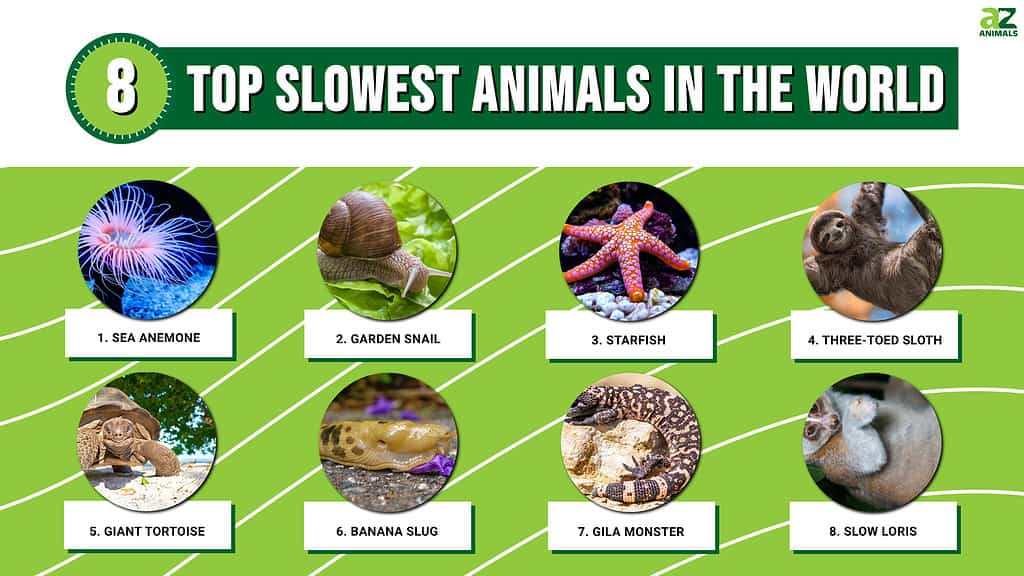
You’ve probably heard that the cheetah, capable of running up to 70 miles an hour, is the fastest land animal. But do you know what the slowest animals in the world are? Ready to find out? We’ve put together a list of the 8 slowest animals in the world. Continue reading to discover just how slow some animals move!
#8. Slow Loris

©Nachaliti/Shutterstock.com
The name may be a giveaway, but the Slow Loris is a very slog animal. They move at just 1.18 miles per hour. These nocturnal primates typically travel about 5 miles at night looking for prey. While they typically move very slowly, when they find prey, they are able to move a bit quicker to strike.
The Slow Loris is the only venomous primate in the world. Their mouth and elbows contain toxins that work to protect them from predators. They’ll spread these toxins over their fur to provide additional protection. This is likely one of the reasons this animal is able to move so slowly without being constantly attacked by predators.
#7. Gila Monster
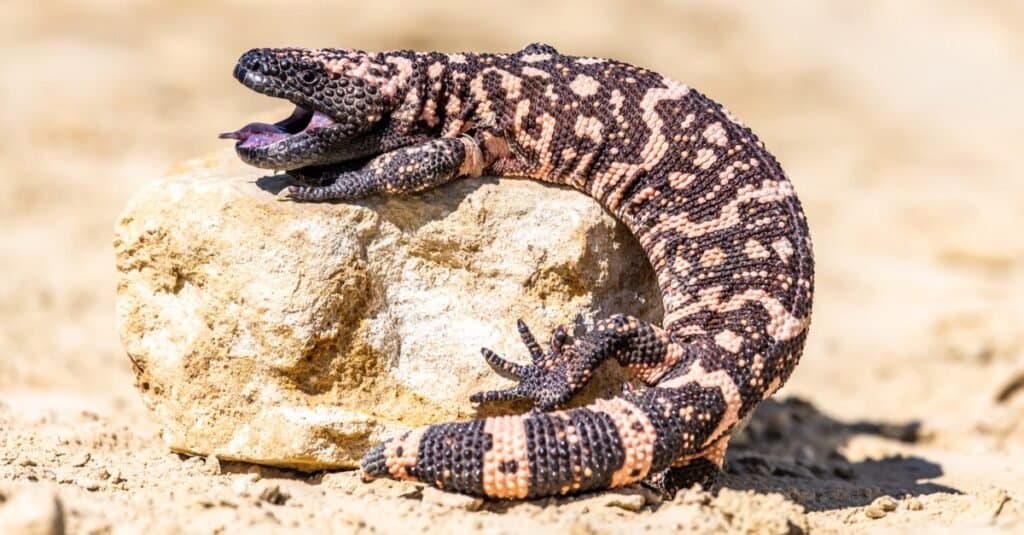
©Vaclav Sebek/Shutterstock.com
The Gila Monster may be faster than some of the other animals on this list, but not by much! They are only capable of running at speeds of about 1 mile per hour. So, while they are the largest lizards that are native to the United States (at about 20 inches long), they are not even close to being the fastest lizards in the country. Most of the day, Gila Monsters spend their time sunbathing.
Gila Monsters are found in the southwestern United States and northwestern Mexico. They live in the Sonoran, Chihuahuan, and Mohave Deserts. Knowing how slow (and lazy) a Gila Monster is, it should be surprising to find out that they look for easy-to-catch pretty. This often includes newborn mammals and eggs. Gila Monsters swallow food whole. They are also able to store fat in their tails and live off of this during the winter when they will remain in the underground home.
#6. Banana Slug
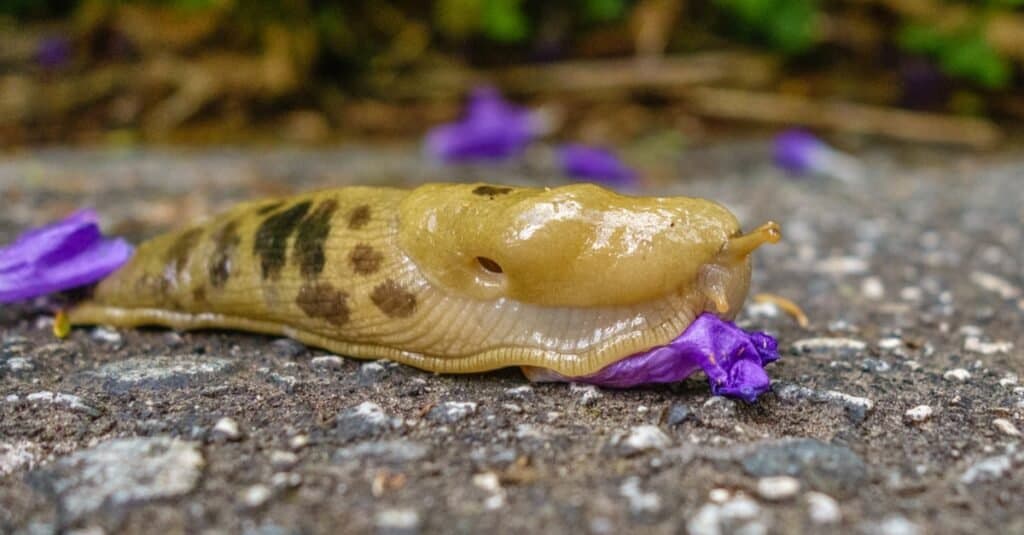
©Heidi Besen/Shutterstock.com
Banana Slugs are another one of the slowest animals on the planet. Banana slugs travel at a pace of around 0.186 miles an hour. That is a staggering 6.5 inches per minute.
They have one foot that makes muscular contractions. These contractions secrete mucus. The mucus turns into slime that allows the slug to lubricate their path to help them move. While slugs are very slow, they are typically faster than their Garden Snail cousins. This may be because they don’t have a shell weighing them down as a Garden Snail does.
Banana Slugs have the ability to rappel down from heights. Their tail holds a mucus gland that allows the slug to make a cord to help them get down.
#5. Giant Tortoise

©Jenny Sturm/Shutterstock.com
If you’ve ever heard the fable “The Tortoise and the Hare,” you may have guessed that a tortoise would make this list. The Galapagos Tortoise is one of the Giant Tortoise subspecies. They only move about 60 yards every 10 minutes. This is a pace of about 0.186 miles per hour. This means it could take all day for a Giant Tortoise to move just four miles. Some Giant Tortoises may move a bit faster with a maximum speed of around 1.2 miles an hour.
The shell of a Giant Tortoise is quite heavy, but it can bear its burden due to the fact that the shell is not solid, but instead composed of honeycomb structures that enclose small air chambers. While the shell no doubt slows the animal down to an extent, another contributing factor is that the front legs of a giant tortoise are turned inward. This causes the animal to move from side to side when it walks, rather than in a straight line.
The Galapagos Tortoise may live to be over 150 years old. Tortoises have also lived on Earth longer than most other creatures. They were around during the time of the dinosaurs.
#4. Three-Toed Sloth

©jdross75/Shutterstock.com
Three-Toed Sloths are very slow animals. Most of the day, they stay in the treetops and hardly move at all. It is believed that their very low metabolic rate is the reason that this mammal is so slow. Sloths move at a speed of just 1 foot each minute or about 0.011 miles per hour. This is such a slow speed that algae even grows on their coats!
Due to a sloth’s slower metabolism, they don’t need to eat very much. They can get by with eating just a few twigs and leaves. Sloths also have a different anatomical structure from other mammals. While their arms are very long, their shoulder blades a very short. This allows them to easily reach farther distances without needing to move too much.
#3. Starfish

©Vojce/Shutterstock.com
Most Starfish move very slowly. Some only travel about 15 centimeters each minute. This works out to be about .005 miles per hour. A Starfish’s arms have special tubes that they use for moving. If a Starfish is looking to travel a farther distance, it may use the ocean currents to help it move more quickly.
Did you know that there are about 2,000 Starfish species? You can find an eye at the end of each arm on a Starfish, and some starfish have as many as 40 arms. Despite their name, Starfish are not fish. Unlike fish, they don’t have scales, fins, or gills. Rather, they are part of the Echinodermata phylum, making them related to sea urchins and sand dollars. Many Starfish, as with other echinoderms, display radial symmetry. This means that the parts of their body are symmetrical around a central axis. This means you can’t clearly tell which side of a Starfish is the “top” or “left side.”
#2. Garden Snail
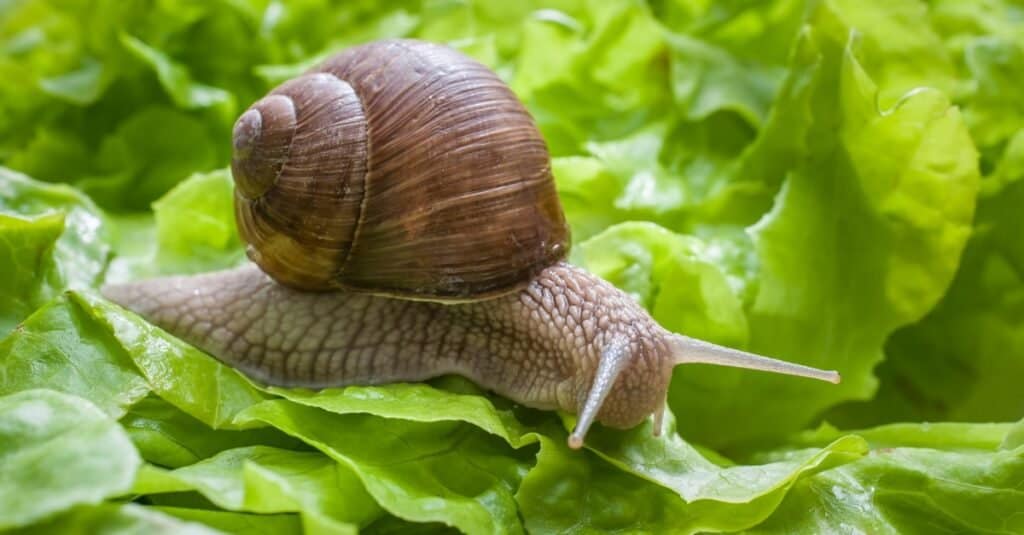
©Alexander Raths/Shutterstock.com
Did you know that Garden Snails only move about one meter each hour? This is a pace of around .0006 miles per hour! To move, the garden snail’s boneless foot makes muscular contractions.
This releases mucus, or slime, that allows the snail to lubricate its path to help them move.
Due to their thick shell on their back, speed isn’t really a necessity for snails trying to escape a predator. They can simply retract into their shell for safety. The heavier shell also slows down its speed.
Some snails have lungs while others still use gills to breath. They are also herbivores and are closely related to the slug, which isn’t the same thing as a snail. If kept alive, some garden snails can actually live from 10 to 15 years! Some snails have been documented to have lived up to 25 years.
#1. Sea Anemone
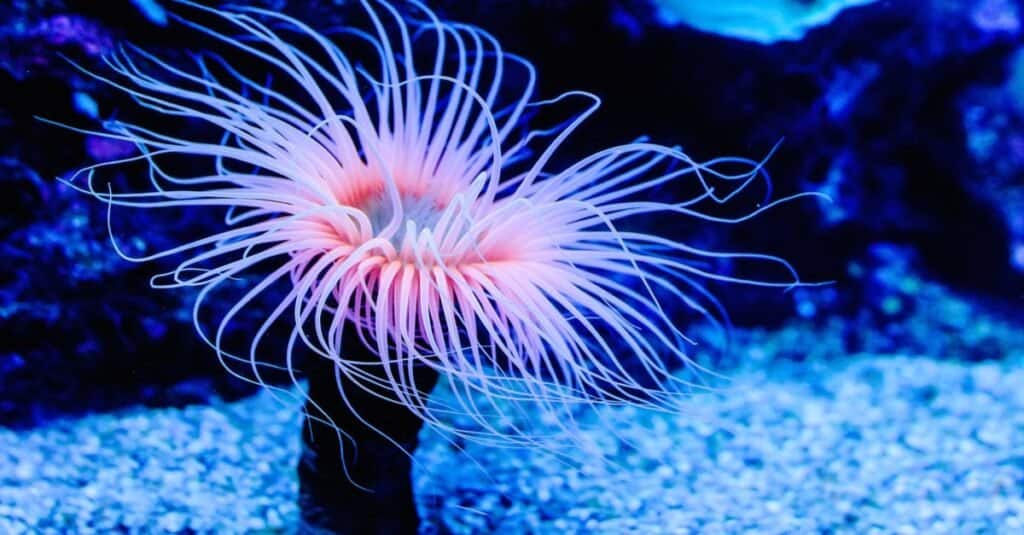
©Natalia Fedori/Shutterstock.com
Sloths may be the slowest land animals, but Sea Anemones are even slower. Most of the time, sea anemones stay still attached to rocks or coral. They like to hunt fish or another pretty that swim close by. However, they will occasionally move from their position. Based on time-lapse photography, it is estimated that Sea Anemones only move about 1 centimeter (about 0.39 inches) an hour! To move, a Sea Anemone uses its pedal disc to slowly shift along on a rock or coral. They are also able to swim and float.
Sea Anemones are invertebrates that use their tentacles to catch prey. Their tentacles sting prey and help guide them into the mouth of the Sea Anemone. Sea Anemones look similar to a flower. Their size can vary quite a bit from a diameter of just 0.5 inches to 6 feet. Most Sea Anemones can be found in tropical waters, but some have made adaptations to living in cooler water.
If you ever feel you’re moving too slowly and can’t keep up with the daily grind, think about some of these sloooooooow animals and how much faster you are than them! Have you seen any of these slow animals in person? Were you surprised by any of the animals that made this list?
Summary of the Top 8 Slowest Animals in the World
| Rank | Animal | “Speed” |
|---|---|---|
| 1 | Sea Anemone | 1 centimeter (about 0.39 inches) an hour |
| 2 | Garden Snail | .0006 miles per hour |
| 3 | Starfish | 0.005 miles per hour |
| 4 | Three-toed Sloth | 0.011 miles per hour |
| 5 | Giant Tortoise | 0.186 miles an hour |
| 6 | Banana Slug | 0.186 miles an hour |
| 7 | Gila Monster | 1 mile an hour |
| 8 | Slow Loris | 1.18 miles per hour |
The photo featured at the top of this post is © Ernie Cooper/Shutterstock.com
Thank you for reading! Have some feedback for us? Contact the AZ Animals editorial team.






